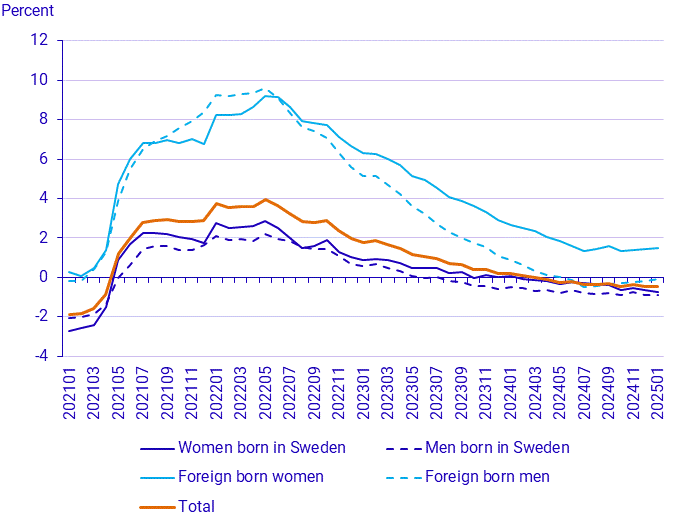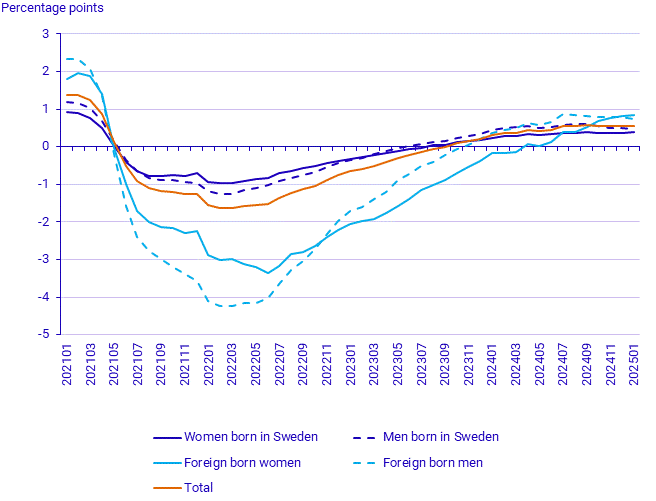Population by Labour market status, January 2025
The labour market remained subdued in January 2025
Statistical news from Statistics Sweden 2025-03-31 8.00
People in employment aged 15 to 74 numbered 5 107 000 in January in 2025. This is a decrease of 25 000 people compared with January 2024. In the 20 to 65 age range, 305 000 people were unemployed. This equals a share of 6.0 percent expressed as a percentage of the labour force and is an increase of 0.6 percentage point compared with the same period of the previous year.
People in employment
The number of people in employment aged 15 to 74 decreased in January by 0.5 percent compared to the same period the previous year, but the trend varies depending on sex and region of birth.

The unemployed
The number of unemployed people aged 20 to 65 in January was 305 000, which is an increase of 29 000 compared to the same period the previous year.
The relative unemployment rate - the proportion of unemployed people in relation to the labour force - was 5.9 percent for women and 6.1 percent for men. This equals an increased unemployment rate among both women and men of 0.6 percentage points, compared with the same period of 2024.
Unemployment is higher among foreign born people than among those born in Sweden. In January the unemployment rate was, among foreign born people 13.1 percent and among people born in Sweden 3.6 percent.

| January 2025 | December 2024 | January 2024 | Change since January 2024 (%) | |
|---|---|---|---|---|
| Employed | 5 107 000 | 5 168 000 | 5 132 000 | ‑0.5 |
| Women | 2 490 000 | 2 519 000 | 2 497 000 | ‑0.3 |
| born in Sweden | 1 935 000 | 1 960 000 | 1 950 000 | ‑0.7 |
| foreign born | 555 000 | 559 000 | 547 000 | 1.5 |
| Men | 2 617 000 | 2 650 000 | 2 636 000 | ‑0.7 |
| born in Sweden | 2 010 000 | 2 037 000 | 2 028 000 | ‑0.9 |
| foreign born | 607 000 | 612 000 | 608 000 | ‑0.1 |
| January 2025 | December 2024 | January 2024 | Change since January 2024 | |
|---|---|---|---|---|
| Employed | 4 779 000 | 4 800 000 | 4 800 000 | ‑0.4 |
| Women | 2 328 000 | 2 336 000 | 2 333 000 | ‑0.2 |
| Men | 2 451 000 | 2 464 000 | 2 467 000 | ‑0.7 |
| Employment rate (%) | 78.4 | 78.8 | 79.0 | ‑0.6 |
| Women | 78.1 | 78.3 | 78.6 | ‑0.6 |
| born in Sweden | 82.8 | 83.1 | 83.3 | ‑0.5 |
| foreign born | 65.3 | 65.6 | 65.8 | ‑0.5 |
| Men | 78.8 | 79.2 | 79.4 | ‑0.6 |
| born in Sweden | 82.2 | 82.7 | 82.8 | ‑0.6 |
| foreign born | 69.5 | 69.9 | 70.1 | ‑0.6 |
| Unemployment | 305 000 | 289 000 | 277 000 | 10.4 |
| Women | 146 000 | 138 000 | 131 000 | 11.0 |
| born in Sweden | 56 000 | 52 000 | 49 000 | 14.7 |
| foreign born | 89 000 | 86 000 | 82 000 | 8.7 |
| Men | 160 000 | 151 000 | 146 000 | 9.9 |
| born in Sweden | 80 000 | 75 000 | 72 000 | 12.5 |
| foreign born | 79 000 | 76 000 | 74 000 | 7.4 |
| Relative unemployment rate (%) | 6.0 | 5.7 | 5.4 | 0.6 |
| Women | 5.9 | 5.6 | 5.3 | 0.6 |
| born in Sweden | 3.0 | 2.8 | 2.6 | 0.4 |
| foreign born | 14.3 | 13.9 | 13.5 | 0.8 |
| Men | 6.1 | 5.8 | 5.6 | 0.6 |
| born in Sweden | 4.1 | 3.8 | 3.7 | 0.5 |
| foreign born | 12.0 | 11.5 | 11.2 | 0.8 |
| January 2025 | December 2024 | January 2024 | Change since January 2024 (%) | |
|---|---|---|---|---|
| Students | 175 000 | 180 000 | 169 000 | 3.9 |
| Women | 98 000 | 102 000 | 95 000 | 3.6 |
| Men | 77 000 | 78 000 | 74 000 | 4.2 |
| Retirees | 76 000 | 73 000 | 83 000 | ‑8.2 |
| Women | 37 000 | 36 000 | 41 000 | ‑9.0 |
| Men | 38 000 | 37 000 | 41 000 | ‑7.4 |
| Sick | 229 000 | 229 000 | 229 000 | 0.2 |
| Women | 126 000 | 126 000 | 126 000 | ‑0.2 |
| Men | 103 000 | 103 000 | 102 000 | 0.7 |
| Others | 529 000 | 522 000 | 517 000 | 2.3 |
| Women | 247 000 | 244 000 | 241 000 | 2.8 |
| Men | 282 000 | 278 000 | 276 000 | 1.9 |
Definitions and explanations
BAS, Population by Labour market status, presents statistics based on administrative data concerning aspects such as number of people in employment, unemployed people, and people outside the labour force for the registered population aged 15 to 74. The statistics can be used to describe current status, but also the progression over time. It illuminates both the entire population and smaller groups, such as detailed age groups at the municipal level.
The statistics contain estimates of the number of people broken down by labour market status: Employed, unemployed, student, retiree, sick and others. The definition of labour market status is hierarchical, which means that a person can only be assigned one labour market status, and it is determined according to the order of precedence above.
The labour force consists of employed people and the unemployed.
The labour market status categories that are outside the labour force are student, retiree, sick and others. There are fewer people outside the labour force in the summer than during other parts of the year. This is mainly because some people who are students during term time work during the summer and are then classified as employed.
Feel free to use the facts from this statistical news but remember to state Source: Statistics Sweden.
